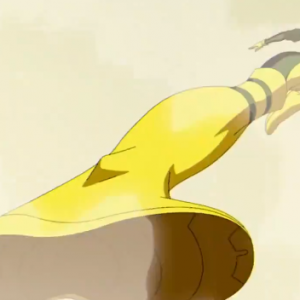The imminent Resident Evil 4 remake, like the original classic, contains a whole lot of destructible crates. However, the crates are now a bit different. As the game’s recent demo suggests, the developers have now marked these boxes with a painted yellow “X” to indicate that you should smash them to bits for the possible goodies they may contain. This pissed off one opinionated fan. “This needs to end,” they tweeted.
It’s happened to all of us before. You’re walking down a fairly linear corridor. Suddenly out of nowhere, you spot a giant sign pointing you in the direction that you were walking in the first place. Or maybe a spotlight is literally shining towards an exit. You’re likely to have one of two reactions: 1) “Wow, that was so helpful!” or 2) “Does the developer think that I’m an idiot or something?” The Twitter OP’s reaction was the latter, but there were plenty of developers who felt that there was a case for the former.
“Elden Ring literally opens with an NPC telling you where to go and that was not enough,” wrote one indie game designer, referring to a popular debate last year over whether or not FromSoft was obligated to make its tutorial entrance more obvious. “So a lot of people skipped the tutorial and complained there was no tutorial.” Some developers had personal stories about playtesters fucking up badly enough that the designers had to heavily signpost. Chet Faliszek, a writer who worked on series like Half-Life, Portal, and Left 4 Dead, quoted the original tweet with the comment, “Someone has never sat in on an observed playtest…” He went on to say, “It’s funny watching the progression of L4D mod maps on the path. Eventually, they break down and just put a sign, a safe room, and an arrow.”
There are players who feel that a slightly different wood texture is enough to communicate destructibility, especially those who played the original Resident Evil 4. But it’s possible that not marking these destructibles in a more overt way made it harder for earlier generations of RE players to get into the full experience. “It’s either this or ‘the glow’ and I promise you when us game developers see the play tests, people skip over environmentally realistic props,” tweeted Dai D., a level designer for Watch Dogs: Legion. Unless you guys want a button prompt to “look at lootables” every time you enter a room, learn to live with the yellow marks!”
G/O Media may get a commission
While designing levels for Legion, Dai quickly found out why giving players leeway and zero direction was a mistake. In the mission “Digging Up The Past,” players were given the opportunity to freely explore with a drone before heading to their objective. Unfortunately, players kept forgetting about the actual quest. “We found that with the newfound camera angle of the [drone], players were too fascinated with where they were, what they were initially doing, and what their character looked like peering through the glass.” Dai described a frustrating process in which it sounded a lot like trying to guide a small infant.
“We ended up having an audio cue and a visual cue in order to keep players on track. We reminded them that there was a vent [they had] to climb to and of course we highlighted the vent (and subsequent vents) in red outline,” they told Kotaku over DMs. “We even had a digital line pointing to the vent in order to keep players focused. We found that players will rarely look up or even use the full functions (even given the “view controls” prompt on the bottom right hand side of the screen) of whatever they’re handling.“
The solution: Sticking the mission objective into players’ faces. Legion has an AI navigator that guides players via audio. The designers used it to nag players incessantly about going to the vent and to remind them about the drone’s jump function. Ubisoft gets flak for its maximalist interface design, to the point where it’s become a gaming meme. You can technically turn off any UI that annoys you, but it’s not something that new players might remember after playing for a few hours. And you never know when you might actually need the game to point you in the right direction.
Bill Gardner faced a different problem while he was a lead designer on BioShock, 2K’s seminal first-person shooter with stealth and immersive sim elements. Playtesters approached the game thinking that it was similar to Half-Life, and so they went in guns blazing.
“When you put yourself out there and do something different, you have to go to great lengths to make sure what you’re doing is 100 percent clear,” Gardner told Kotaku over Twitter DMs. He described a particularly frustrating incident where a playtester didn’t understand that a machine was actually a resurrection device. “In that test, we had one user walk up to Vita-Chamber and stare at it for about two minutes. Mercifully, they moved on… and then picked up the wrench. Progress! Unfortunately, they then did a 180, went back to that same Vita-Chamber and proceeded to smash it with the wrench for probably another four minutes.” Personally, I’m amazed that they didn’t give up on smashing the chamber after 10 seconds. But in those playtests, it seemed that genre logic overrode the players’ reasoning abilities. Gardner believes that designing in ways that account for those pre-formed genre expectations is one of the big challenges when innovating with gameplay.
“Shooters were mostly about running down a hall and blasting the first thing that popped up,” he wrote. “There were exceptions of course. But most of the masses were not used to having a weapon and not smashing everything that moved and [things] that didn’t move.” There were other non-combat sequences in which the developers tried to dissuade players from attacking, such as the Big Daddy’s introduction sequence. They tried to use subtle audio cues. Players started attacking anyway.”
Storytelling isn’t immune to being designed around the lowest common denominator, either. Gardner told Kotaku that, when working on their horror game Perception which features a blind protagonist, the team faced a major issue of players failing to grasp the game’s concept. They were receiving positive feedback from playtests three to four months prior to launch, but one playtester question incited doubt among the developers: “I really like how you told the story and the atmosphere, there was just one thing I didn’t quite get…was she blind?”
That question caused the “mortified” designers to make a major change. They asked the lead actress to record the entirely new line, “When you’re blind, you learn a thing or two about trust.” While the dialogue sounds a little overdone when taken out of context, it was meant to correct an actual negative experience that a player had with the game.
The person whose tweet kicked off this discourse, and whose Twitter account focuses on first-person shooters and their aesthetics, started a poll about paint signposting, and it seems like most players agree with the developers. People would rather have overly obvious guides than miss something important. But even people who hate this less subtle interface design have reason to rejoice. Elden Ring, which certainly doesn’t do much signposting for the player, sold extraordinarily well last year, and plenty of gamers have shown that they can enjoy a game without being told exactly what to do. Additionally, Horizon Forbidden West has a togglable climbing guide, and as accessibility and customization settings improve, perhaps we’ll start seeing these kinds of environmental clues more often become an option that players can have on or off as they see fit. Already in 2023, it’s not difficult to find something that fits your personal taste.





the1.21updateofficialnameis..._minecraftmonthly-youtube-googlechrome4_26_20242_39_36pm-300x300.png)


















